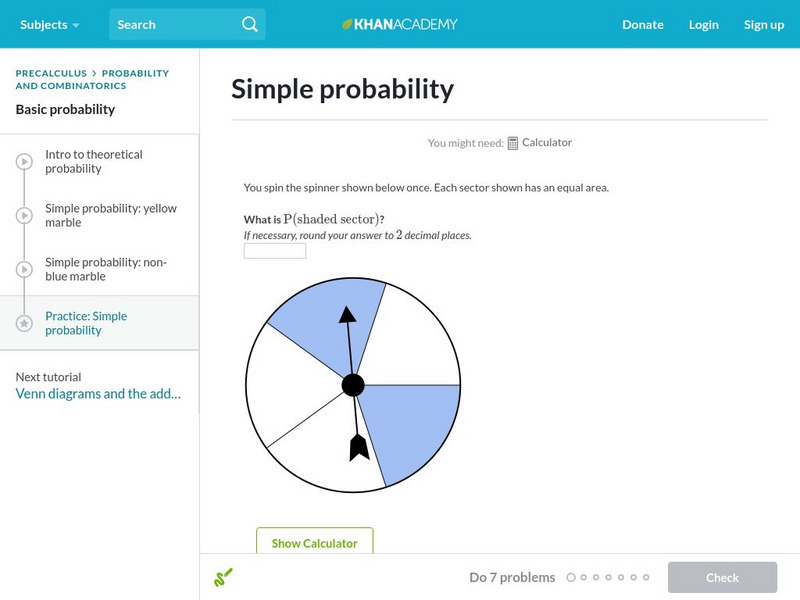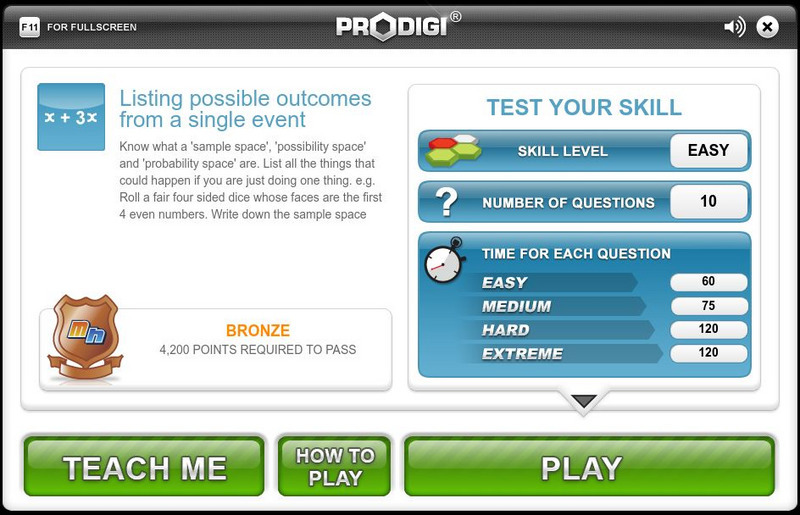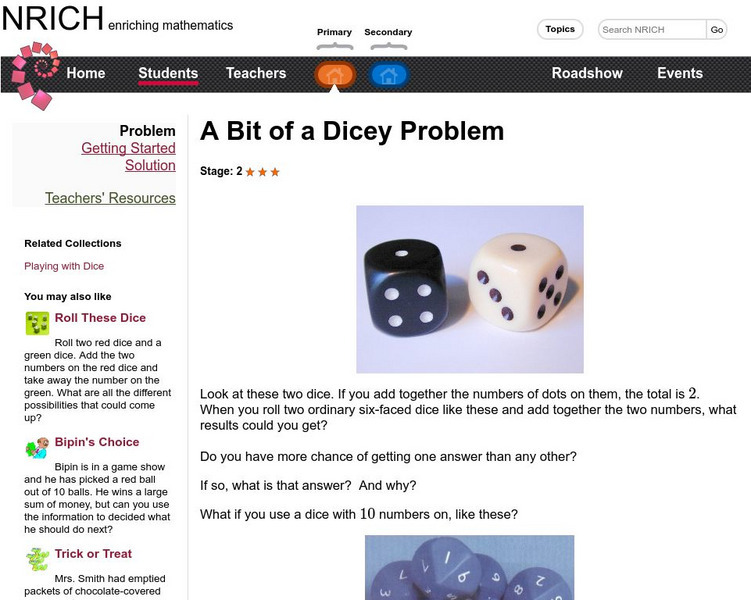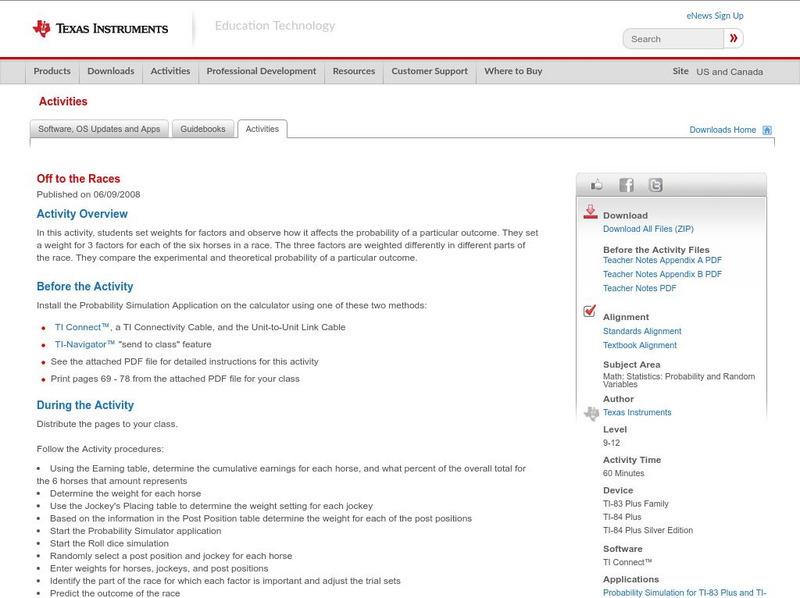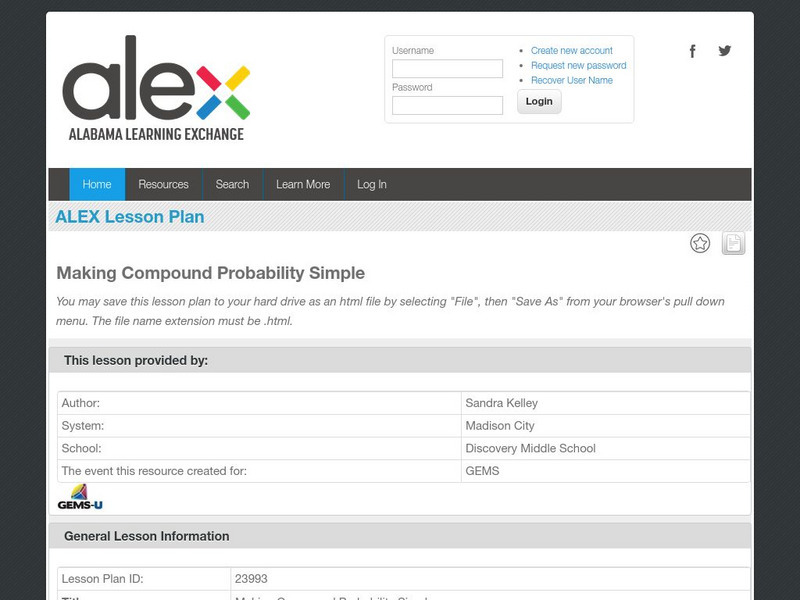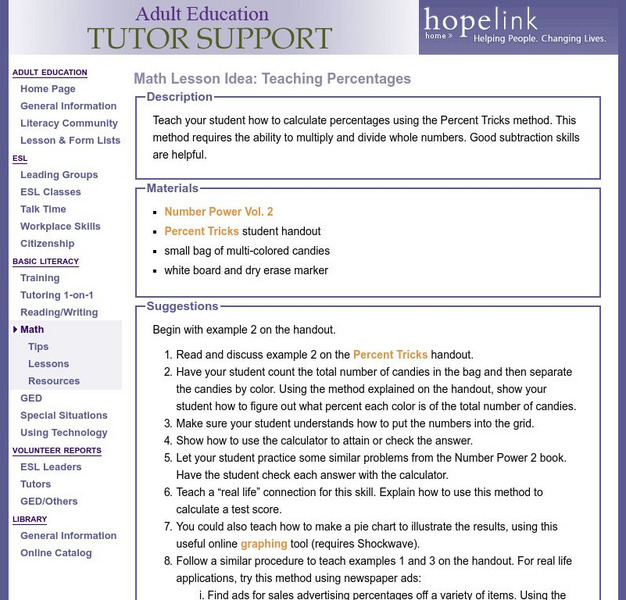Hi, what do you want to do?
Texas Instruments
Texas Instruments: You're Probably Right, It's Wrong
In this activity, students perform a simulation to guess answers on a test and determine the experimental probability of passing the test. They then compare it with the theoretical probability.
McGraw Hill
Glencoe: Self Check Quizzes: Theoretical Probability
Use Glencoe's randomly generated self-checking quiz to test your knowledge of theoretical probability. Each question has a "Hint" link to help. Choose the correct answer for each problem. At the bottom of the page click the "Check It"...
Sophia Learning
Sophia: Finding the Probability of Two Mutually Exclusive Events
This lesson demonstrates how to find the probability of two mutually exclusive events.
PBS
Pbs Mathline: The Smithville Families Lesson Plan [Pdf]
A coin is used to determine the birth of children and the students are to determine the probability of whether the child is boy/girl. Printable lesson.
Khan Academy
Khan Academy: Simple Probability
Practice finding probabilities of events, such as rolling dice, drawing marbles out of a bag, and spinning spinners. Students receive immediate feedback and have the opportunity to try questions repeatedly, watch a video or receive hints.
Scholastic
Scholastic: Study Jams! Math: Probability: Find Probability
This site provides great practice on the concept of probability. Students can first learn about the topic by watching a step by step instruction video that also points out areas of concern. Finally, students can practice their knowledge...
Khan Academy
Khan Academy: Theoretical and Experimental Probability: Coin Flips and Die Rolls
A set of questions on experimental and theoretical probabilities using coins and dice. Answers are accompanied by explanations.
Shodor Education Foundation
Shodor Interactivate: Lesson: Ideas That Lead to Probability
This lesson plan sets the ground work for an introduction to and then exploring the concepts that are the foundation for probability. Lots of resources are available for teachers and students at this website.
Oswego City School District
Regents Exam Prep Center: Mutually Exclusive & Independent Events
The somewhat tricky differences between mutually exclusive, non-mutually exclusive, independent, and dependent events are defined here. Common items such as coins, colored cubes, and a deck of cards are all part of the easy-to-understand...
Mangahigh
Mangahigh: Data: Listing Possible Outcomes From a Single Event
Students learn about the concept of outcomes by exploring a tutorial. They can then test their knowledge by taking a ten question assessment that increases in difficulty as they correctly answer questions.
University of Cambridge
University of Cambridge: Nrich: A Bit of a Dicey Problem
Short website offers a look into the theoretical probability of tossing dice. Several questions related to the throwing of dice are included.
Texas Instruments
Texas Instruments: Off to the Races
In this activity, students set weights for factors and observe how it affects the probability of a particular outcome. They set a weight for 3 factors for each of the six horses in a race. The three factors are weighted differently in...
Alabama Learning Exchange
Alex: Making Compound Probability Simple
This lesson plan asks students to find all the possible outcomes from a compound event. Students will create a powerpoint, booklet, or foldable to demonstrate their understanding of the methods for solving compound events. It also...
ClassFlow
Class Flow: Probability Starter: Handling Data
[Free Registration/Login Required] Students are introduced to the concept of theoretical and actual probability in a variety of contexts.
University of Cambridge
University of Cambridge: Nrich: In a Box
This probability problem encourages the learner not only to arrive at a solution, but also to defend it.
Alabama Learning Exchange
Alex: Don't Compound the Problem
Students will be able to determine the probability of a compound event. Drawing on their knowledge of simple probability to find the probability of more complex outcomes. Students will create a poster, PowerPoint, booklet, or foldable to...
National Council of Teachers of Mathematics
Nctm: Illuminations: Adjustable Spinner
An interactive game for learning theoretical vs experimental probability.
Texas Instruments
Texas Instruments: Analyzing Number Cube Sums
In this activity, students extend their understanding of theoretical probability and patterns. They use number cubes, to build awareness that a fraction and its decimal and percent representation on the calculator are "close," but not...
Alabama Learning Exchange
Alex: Puzzling Pangaea
In this lesson learners will work collaboratively to research information in order to prove or disprove if a super continent ever existed. Students will create a model of Pangaea to show how their research findings 'connect' in a puzzle...
National Council of Teachers of Mathematics
The Math Forum: The Cereal Box Problem
A cereal company is offering six different prizes in their boxes. How many boxes would you expect to have to purchase in order to collect all six prizes? Known as the Cereal Box Problem, this question is explored here. A solution is...
Sophia Learning
Sophia: Sampling and Prediction: Lesson 3
This lesson demonstrates how sampling can help predict outcomes. It is 3 of 2 in the series titled "Sampling and Prediction."
Sophia Learning
Sophia: Sampling and Prediction: Lesson 1
This lesson demonstrates how sampling can help predict outcomes. It is 1 of 2 in the series titled "Sampling and prediction."
Hopelink
Hopelink: Teaching Percentages
Students can brush up on percentage skills with this lesson and calculate percentages using the "Percent Tricks method." For students to successfully use this method, they must have the ability to multiply and divide whole numbers.







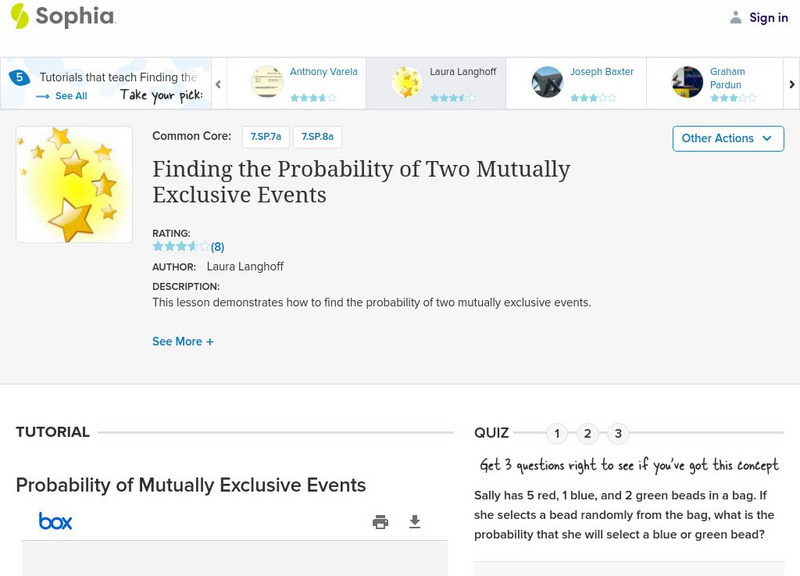
![Pbs Mathline: The Smithville Families Lesson Plan [Pdf] Lesson Plan Pbs Mathline: The Smithville Families Lesson Plan [Pdf] Lesson Plan](https://static.lp.lexp.cloud/images/attachment_defaults/resource/large/FPO-knovation.png)
